FMS Models 1400mm Kingfisher PNP
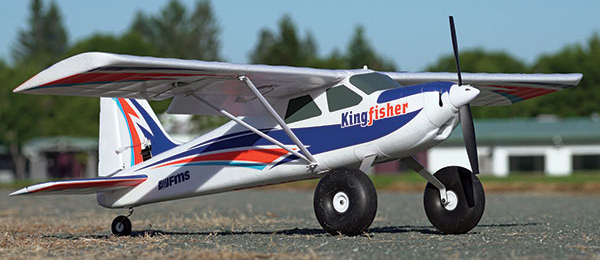
Written by Jon Barnes A versatile trainer with a trio of landing gear options Product Review As seen in the November 2018 issue of Model Aviation
Bonus Video
Specifications
Model type: Foam trainer Skill level: Beginner Wingspan: 55 inches Wing area: 451 square inches Length: 36 inches Weight: 50 ounces Power system: Brushless electric (included) Radio: Minimum five channels required Construction: EPO foam Price: $219.99Test-Model Details
Motor used: Predator 3536/850 Kv brushless outrunner (installed) Speed Predator 40-amp with controller: integrated 5-amp BEC and EC3 connector (installed) Battery: 3S 11.1-volt, 35C 2,200 mAh LiPo Propeller: 11 x 7 (installed) Radio system: Spektrum DX9 2.4 GHz transmitter; Spektrum AR6110e 2.4 GHz receiver Ready-to-fly weight: 52 ounces Flight duration: 7 to 10 minutesPluses
• Included landing gear with oversize tundra tires, floats, and skis allow this model to be operated from nearly every possible type of terrain. • Includes an FPV cockpit hatch to easily mount a camera. • Reinforced towline attachment point allows model to function as a towing platform. • The tail wheel can be quickly swapped out with the included water rudder.Minus
• Tail-dragger configuration landing gear can be challenging for beginner pilots just earning their wings.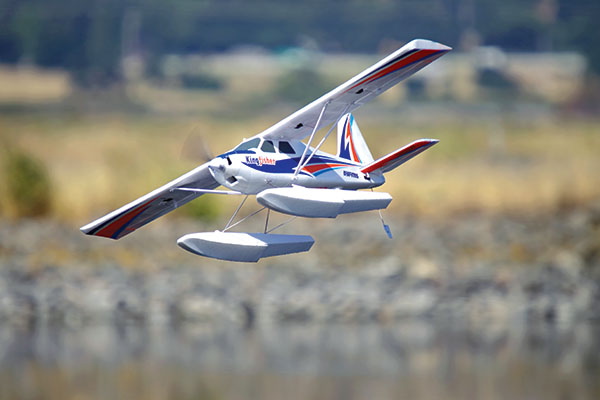
Pilots who are new to water operations will find that the Kingfisher’s flaps can substantially shorten the distance required for taking off and landing on water.
Product Review
As one of the industry’s leading designers and manufacturers of electric-powered RC aircraft, FMS Models has a vested interest in keeping a trainer or two in its arsenal of aircraft offerings. Previous trainer models used by FMS to attract newer pilots included the 1,220 mm wingspan Super EZ and 1,280 mm wingspan Easy Trainer. This year, FMS ups the ante with the release of a new, larger wingspan trainer model, the 1,400 mm wingspan Plug-n-Play (PNP) Kingfisher. As do most recent releases from FMS, the Kingfisher features an EPO foam-composition airframe and is powered by a brushless electric power system. All of the electronics are included with the kit, requiring that pilots only need to provide a minimum five-channel radio system and a three-cell, 11.1-volt, 2,200 mAh LiPo battery.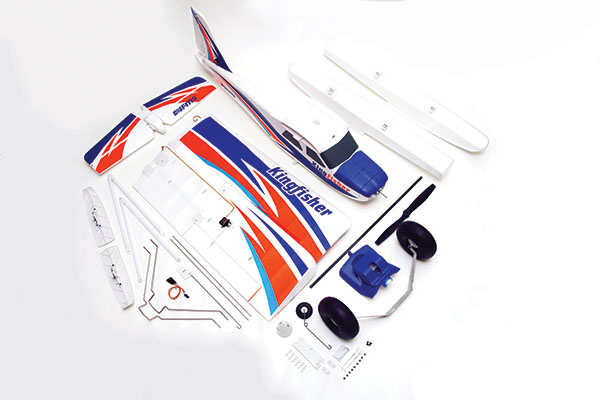
The Kingfisher continues the FMS tradition of using a quasi-modular, screwless assembly method. The wing on the final production Kingfisher includes flaps.
In the last few years, the industry has seen the emergence of a new subgenre of trainer-type models that mimic—if only in stand-off scale fashion—the popular, go-anywhere, Short Takeoff & Landing (STOL) class of adventure-focused, recreational, full-scale aircraft. One of the signature attributes of this type of airplane is oversize tundra tires. FMS signals its intent to compete with the variety of other models already available in this class by outfitting the Kingfisher with a set of oversize, rugged, large-diameter tires.
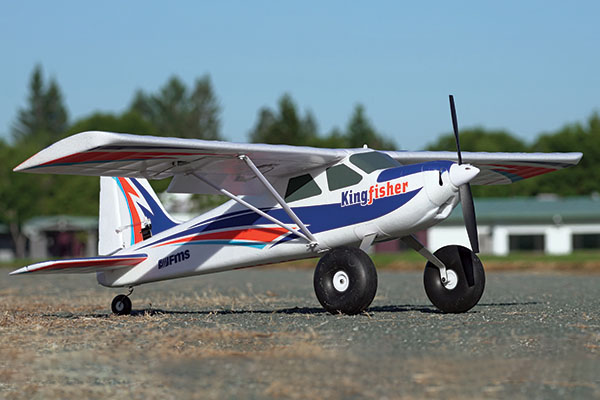
Large-diameter tundra tires allow the Kingfisher to launch and land from rough terrain.
In the true spirit of adventure emboldened by this type of airplane, the FMS Kingfisher kit also includes a set of EPO foam floats and a pair of snow skis! The included landing gear options theoretically allow the Kingfisher to be operated from almost any surface and in any weather conditions. This feature alone should give the Kingfisher a leg up when it comes to appealing to modelers from all environments and climates.
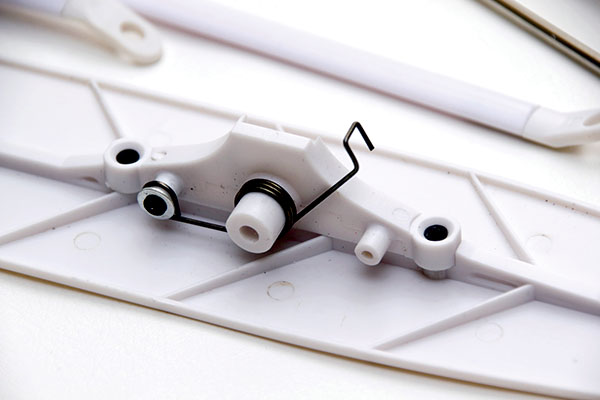
For optimal operations off of snow and ice, a spring-loaded torsion mechanism tensions the plastic skis into a slightly tips-high orientation.
An additional feature that is sure to pique the interest of many modelers is the inclusion of an FPV camera-friendly, removable cockpit hatch. Pilots interested in using this electric-powered model as an FPV platform will find that mounting either an action camera or an FPV camera on the Kingfisher is as easy as attaching it to the second cockpit/hatch and snapping it into place on the fuselage. No self-respecting, STOL-capable, all-terrain airplane would be caught dead without flaps. Although an early, preproduction sample of this model lacked flaps, FMS actively monitors its social media channels and willingly responded to requests made by those interested in acquiring this newly announced model. This resulted in adding flaps to the Kingfisher during its final, preproduction design review. One caveat to this additional feature is that the use of foam hinges on the Kingfisher’s flaps in lieu of either more active, pin-style hinges or the use of fowler-style flaps, limits them from achieving the more extreme angles of flap deployment typically reached by models of this ilk.
Assembly
The latest trend for EPO foam-based models is for the manufacturers to practically negate the need for any adhesives during assembly. The Kingfisher takes this a step further with its toolless airframe assembly design. Modelers only need to insert the carbon-fiber spar through the fuselage center section and slip each wing half into place on the spar. The wing halves lock into place on the fuselage with an authoritative snap. The included plastic wing struts are pinned in place using small clevis clips. Removing the wing halves for transport and storage is as simple as depressing the spring-loaded release tabs. The horizontal stabilizer/elevator assembly similarly snaps into place on the aft end of the fuselage using a cleverly engineered plastic retention clip without needing fasteners or tools. The only part of the airframe that will have modelers reaching for their toolboxes is the tail wheel assembly. The tail wheel assembly can be quickly swapped out with the included water rudder; a cutover is required when readying the airplane for water-based operations. FMS includes the metal struts and braces used to mount the included foam floats to the Kingfisher. After the floats are assembled, they can be quickly mounted to the underside of the aircraft using seven machine-threaded fasteners. Swapping back to the large-diameter fixed gear takes roughly 5 minutes. The Kingfisher’s third landing gear option, a pair of short plastic skis, allows modelers to operate it off of snow and ice. Attaching the skis requires removing the oversized tundra tires. The skis slip into place over the axles. A sturdy spring retention clip grips the beefy aluminum landing gear to securely hold them in place. This also tensions the skis into a slightly tips-up orientation. Access to the battery bay is via a tongue-and-latch-retained, removable cockpit hatch. Outfitting the Kingfisher with either an action or FPV camera can be done without any need to cut into or otherwise mar or modify the airframe, thanks to the included and interchangeable camera mount cockpit hatch.Flying
It is difficult to come up with a terrain scenario from which this model cannot theoretically be operated! The trifecta of gear allows pilots to fly the Kingfisher from nearly any surface and in almost any season and weather. At roughly 5 inches in diameter, the oversize tundra tires capably soak up and roll over even the most eroded land-based runway. With the flaps deployed to the takeoff or landing positions, the Kingfisher will jump into the air merely seconds after applying a burst of throttle. A judicious amount of flap-to-elevator mix is needed to offset the amount of ballooning exhibited by the Kingfisher when the flaps are deployed. Whether flying from water, snow, or land, the large flaps allow pilots to execute slow and controlled short-field approaches. FMS markets this model as a beginner aircraft, which means that it will no doubt catch the attention of novice pilots. The greenest of pilots, especially those who are taking on the Kingfisher as their first RC aircraft, might be challenged by the nuances inherent to models equipped with tail-dragger configuration landing gear. Traditional trainer models typically utilize tricycle gear in order to keep a newer pilot’s initial workload light. When it is in the air, the Kingfisher offers a stable and predictable platform with which to practice and perfect his or her piloting prowess. There is plenty of power on tap, allowing this model to perform basic aerobatic maneuvers and aggressive departures and climbouts. The stall is soft and straightforward, with the model typically signaling its impending arrival with a gentle rocking of the wing. Pilots can use the Kingfisher to tow a banner using the included towline attachment point; however, those interested in using the Kingfisher to tow a glider or sailplane aloft will have to engineer a release mechanism. When operating this model from water, the included water rudder provides the right amount of yaw authority to permit taxiing the Kingfisher around on the water’s surface. When operating from land, the tail wheel offers the same capabilities. When switching to skis for operations off of snow or ice, pilots will find that the tail wheel and rudder still manage to work together to provide the yaw authority necessary for taxiing and other related ground-based maneuvers, although the tail wheel appears to be little more than a potential core around which wetter snow can effectively attach and build a small snowball.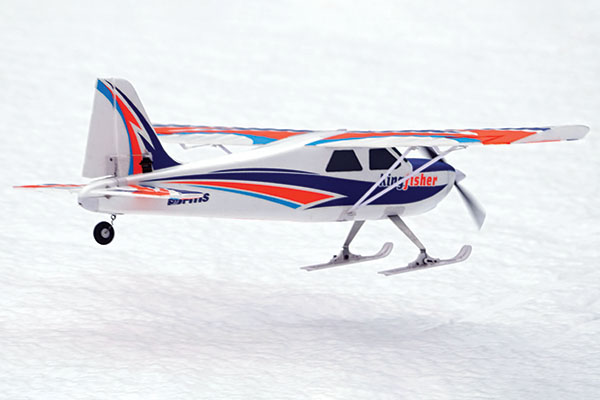
The stock tail wheel does a surprisingly good job of steering the Kingfisher while taxiing on snow and ice.
All things considered, the Kingfisher easily handles the variety of runway scenarios. Although any model’s ultimate flight durations will vary relative to a pilot’s preferred style of flying and throttle usage, the Kingfisher’s brushless power system, low stall speed, and relatively benign in-flight behavior should allow economy-minded pilots to stretch their flight durations to 10 minutes by exercising restraint on the gas pedal. The generous dimensions of the battery bay mean that pilots can probably go with a battery pack that is larger than the recommended 3S 2,200 mAh LiPo, although there is limited room to shift its location rearward in order to maintain the recommended center of gravity.
Conclusion
If variety is the spice of life, the FMS Kingfisher is a veritable spice rack on its own! The triple play of landing gear options included in the box, as well as the towline attachment point and second camera-capable canopy hatch, are sure to keep adventurous pilots busy exploring the full capabilities of this multirole trainer. This thoughtfully engineered airframe allows pilots to quickly ready this model for its first flights and then rapidly switch between tires, floats, and skis. The toolless wing attachment allows pilots to easily break down the model for transport and storage. Although pilots currently have more than a few options when selecting a foam-composition, electric-powered, STOL-capable model, the abundance of features that are included with the FMS Models Kingfisher give it a serious amount of bang for the buck!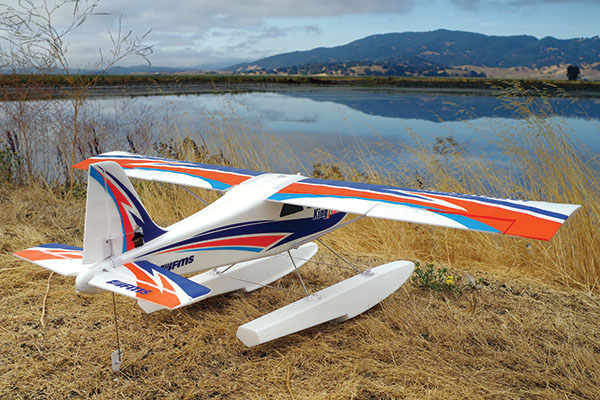
The Kingfisher lives up to its namesake by being comfortable in the aquatic environment.
—Jon Barnes [email protected]










2 comments
I am impressed by current FMS
king air
Add new comment